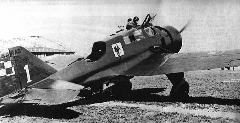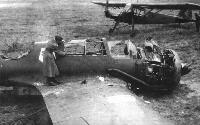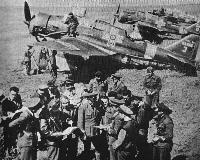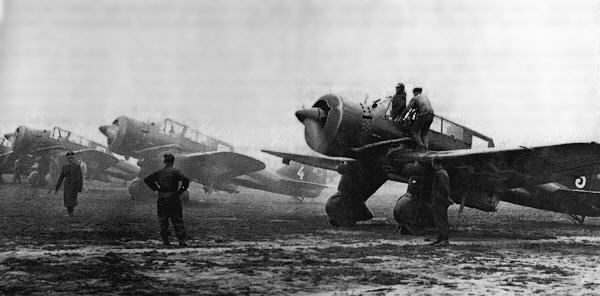
PZL P.23 Karas (crucian carp) was developed in the early 1930s
in response to the Polish Air Force's need to replace its ageing biplane
Potez 25 and Potez 27 light bomber/reconnaissance aircraft. The specification
presented to PZL in 1931 (Panstwowe Zaklady Lotnicze - the State
Aviation Works) called for an all-metal light bomber plane powered by a
Bristol Pegasus air-cooled radial engine, which should carry a minimum
600 kg (1330 lb) bomb-load, and whose maximum speed should reach 300 km/h
(186 mph). Another requirement was the ability to operate from improvised
airfields. It was soon decided that the new plane's design would be based
on the PZL 13 fast passenger/transport airplane project by Stanislaw Prauss,
which had been abandoned in early 1931.
 |
The first PZL P.23 prototype
|
Necessary changes to the project, apart from fuselage redesign, included
the addition of wing flaps, and the provision for weapons mountings. The
wing was designed by Franciszek Misztal, based on his original stressed-skin
main spar concept, which had earlier been only tested on the PZL 19 high-performance
touring airplane. Serious problems with the wing's construction caused
delays, and the first prototype, powered by the Bristol Pegasus
II M2 engine made its maiden flight in August 1934.
The first prototype revealed many problems, which were overcome by the
second and third prototypes. The fuselage was redesigned, with internal
bomb bay removed to provide more space for the crew, and engine installation
lowered for better visibility. The wing's mechanization was redesigned
with automatic slats added on the leading edge, and the wing root fairings
significantly enlarged. After additional changes to the engine fairing
and the exhaust, the airplane was accepted by the Lotnictwo Wojskowe
and given the designation PZL P.23A Karas. An order for 200 aircraft
was placed with the PZL.
 |
PZL P.23B at Cracow Rakowice airfield, spring 1939
|
The production started in the end of 1935 but its pace suffered because
of frequent problems with the Pegasus II M2 engines, license-built
by the Polish Skoda works (this engine variant was never produced
by Bristol). In addition, the leading-edge slats proved unreliable, and
were consequently removed. Only 40 P.23As were built and assigned to training
duties, pending the availability of the P.23B variant fitted with the more
powerful Bristol Pegasus VIII engine, whose production commenced
in the summer of 1936. In February 1937 the production reached the pace
of 20 aircraft per month, and the original order for 200 P.23s was fulfilled
in September 1937. Additional 50 aircraft were ordered, and the production
of the P.23B variant concluded in February 1938.
Meanwhile, an effort was being made to adapt the P.23 for the dive-bombing
role, which resulted in a prototype designated PZL P.42. Although the plane's
dive-bombing capabilities proved poor, it became the basis for the more
successful PZL 46 Sum horizontal bomber which was supposed to replace
P.23s in first-line units starting form March 1940.
 |
One of the first P.43s at Warsaw's Okecie airfield
|
In early 1936 Bulgaria placed an order for 12 P.23s, with the additional
requirement of a more powerful engine and an additional forward-firing
machine gun. The fuselage was thus redesigned to accept the Gnome-Rhone
14N-01 engine, and the plane was given the designation PZL 43A Tchaika
(sea gull in Bulgarian). Because of delays in engine shipments from France,
this first series was eventually fitted with Gnome-Rhone 14kfs engines,
while additional 42 planes ordered by Bulgaria, designated PZL 43B, received
the intended GR 14N-01 engine. At the outbreak of war nine of these aircraft
were still at the Warsaw Okecie airfield, and five of them saw combat in
the Polish Campaign.
 |
A crashed P.23 of 41 Eskadra being examined by German soldiers, September
1939
|
During the September campaign 114 P.23s were flown by first-line units,
and additional 11 (including the five PZL 43s) were received as replacements.
Of these, only 17 reached Romania on September 17. Such a high attrition
rate was caused in most part by the inability to repair the aircraft, so
a large proportion of the planes was abandoned after receiving combat damage.
Still, used for attacks on heavily defended German motorized and Panzer
columns, flying without fighter escort, many planes were lost in combat.
 |
Romanian P.23s on the eastern front, summer 1941
|
After the collapse of Poland, about 30 P.23s from both first-line and
training units reached Romania. After receiving a major overhaul, 19 of
these aircraft were impressed for local service, and saw combat on the
eastern front, flying reconnaissance and bombing missions over the Crimea
and Don river, and were withdrawn from the front in January 1943, following
the collapse of the Axis troops at Stalingrad. From the summer of 1943
the remaining Romanian P.23s were relegated to training duties.
The PZL 43 equipped units of the Bulgarian air force never saw front
line combat, and were used locally against communist guerillas throughout
1943 and 1944. In September 1944, after Bulgaria switched sides and joined
the Allies, the Tchaikas were finally replaced by aircraft of indigenous
design. |






